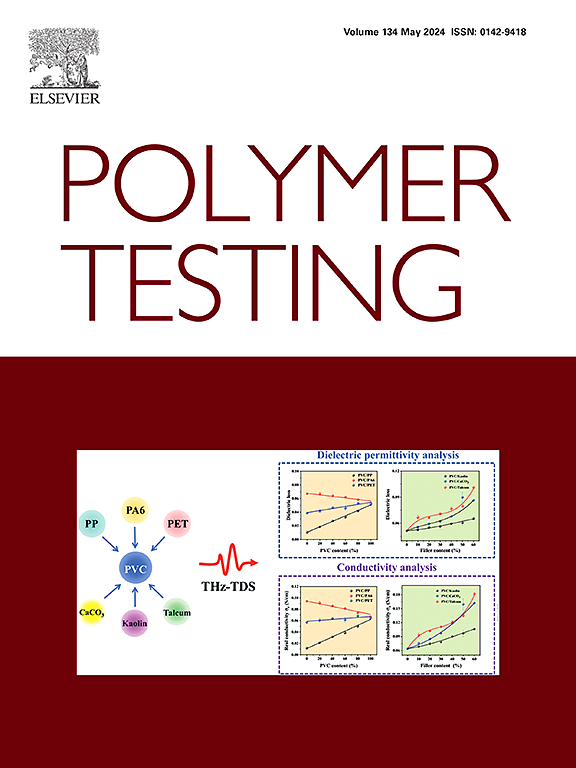Wear, mechanical and chemical properties of castor oil toothbrush bristles
IF 5
2区 材料科学
Q1 MATERIALS SCIENCE, CHARACTERIZATION & TESTING
引用次数: 0
Abstract
Manual toothbrushes with polyamide bristles are used for daily oral hygiene. Toothbrush bristles made from alternative raw materials like castor oil are increasingly produced but scarcely investigated. Medium hardness toothbrushes with bristles made of castor oil (AlterraBambus (ALT), Alverde (ALV), Dr. BestGreenClean (DRB), HydrophilBambus (HYD), ProkudentRecycling (PRO)) and one control toothbrush (ADAcontrol (ADA)) (n = 8) were investigated for wear, dentin-surface-roughness, elastic modulus and chemical composition. Toothbrushes were subjected to 12.5k, 25k, 37.5k and 50k cycles (toothbrush-simulator) simulating 6 months of toothbrushing. Macroscopic and microscopic (50 × magnification, SEM/micro-CT) images of bristle-ends, surface and overall quality were evaluated before and after mentioned intervals according to DIN_EN_ISO_20126. Data were statistically analyzed (Friedman-Test; ANOVA). No obvious wear was visible in macroscopic images. SEM-images showed acceptable bristle-ends in ADA (100 %) and DRB (100 %), PRO (96 %), ALV (87 %), ALT (82 %) and HYD (73 %), while bristle-surfaces were unacceptable only in HYD at 0 and 12.5k cycles. Overall evaluation was acceptable in ADA and DRB (100 %), PRO (96 %) ALV (84 %), ALT (82 %) and HYD (51 %) with significant difference in ALV and HYD at different intervals. Dentin-surface-roughness ranged from 3.4 to 3.8 μm (HYD-ALT), dentin-abrasion ranged from 60 to 95 μm (ALV-ALT) and elastic modulus ranged from 1.14 to 1.81 GPa (PRO-ALT) at baseline and from 0.61 to 1.11 GPa (PRO-ADA) after 50 k cycles. Bristles had similar elemental compositions: carbon (54.6–62.7 %), nitrogen (19.4–24.3 %) and oxygen (16.0–21.1 %), in agreement with ADA. Bristles of toothbrushes except HYD had acceptable bristle ends and surfaces. Dentin-surface-roughness, mechanical and chemical properties of castor oil bristles were similar to those of conventional polyamide bristles.
蓖麻油牙刷刷毛的磨损、机械和化学性能
聚酰胺刷毛手动牙刷用于日常口腔卫生。用蓖麻油等替代原料生产的牙刷刷毛越来越多,但几乎没有研究。研究了中等硬度的蓖麻油刷毛牙刷(AlterraBambus (ALT)、Alverde (ALV)、Dr. BestGreenClean (DRB)、HydrophilBambus (HYD)、ProkudentRecycling (PRO))和一支对照牙刷(adcontrol (ADA)) (n = 8)的磨损、牙本质表面粗糙度、弹性模量和化学成分。牙刷进行12.5k, 25k, 37.5k和50k循环(牙刷模拟器)模拟6个月的刷牙。根据DIN_EN_ISO_20126标准对上述时间间隔前后的刚毛末端、表面和整体质量进行宏观和微观(50倍放大,SEM/micro-CT)图像评价。对数据进行统计学分析(Friedman-Test;方差分析)。宏观图像未见明显磨损。扫描电镜显示,ADA(100%)、DRB(100%)、PRO(96%)、ALV(87%)、ALT(82%)和HYD(73%)的刷毛末端是可接受的,而只有HYD在0和12.5k循环时的刷毛表面是不可接受的。ADA和DRB(100%)、PRO(96%)、ALV(84%)、ALT(82%)和HYD(51%)的总体评价均可接受,ALV和HYD在不同时间间隔的评价差异有统计学意义。牙本质表面粗糙度范围为3.4 ~ 3.8 μm (HYD-ALT),牙本质磨损范围为60 ~ 95 μm (ALV-ALT),弹性模量范围为1.14 ~ 1.81 GPa (PRO-ALT),循环50 k后弹性模量范围为0.61 ~ 1.11 GPa (PRO-ADA)。刷毛的元素组成相似:碳(54.6 - 62.7%)、氮(19.4 - 24.3%)和氧(16.0 - 21.1%),与ADA一致。除HYD外,所有牙刷的刷毛末端和表面均可接受。蓖麻油刷毛的牙本质-表面粗糙度、机械和化学性能与常规聚酰胺刷毛相似。
本文章由计算机程序翻译,如有差异,请以英文原文为准。
求助全文
约1分钟内获得全文
求助全文
来源期刊

Polymer Testing
工程技术-材料科学:表征与测试
CiteScore
10.70
自引率
5.90%
发文量
328
审稿时长
44 days
期刊介绍:
Polymer Testing focuses on the testing, analysis and characterization of polymer materials, including both synthetic and natural or biobased polymers. Novel testing methods and the testing of novel polymeric materials in bulk, solution and dispersion is covered. In addition, we welcome the submission of the testing of polymeric materials for a wide range of applications and industrial products as well as nanoscale characterization.
The scope includes but is not limited to the following main topics:
Novel testing methods and Chemical analysis
• mechanical, thermal, electrical, chemical, imaging, spectroscopy, scattering and rheology
Physical properties and behaviour of novel polymer systems
• nanoscale properties, morphology, transport properties
Degradation and recycling of polymeric materials when combined with novel testing or characterization methods
• degradation, biodegradation, ageing and fire retardancy
Modelling and Simulation work will be only considered when it is linked to new or previously published experimental results.
 求助内容:
求助内容: 应助结果提醒方式:
应助结果提醒方式:


